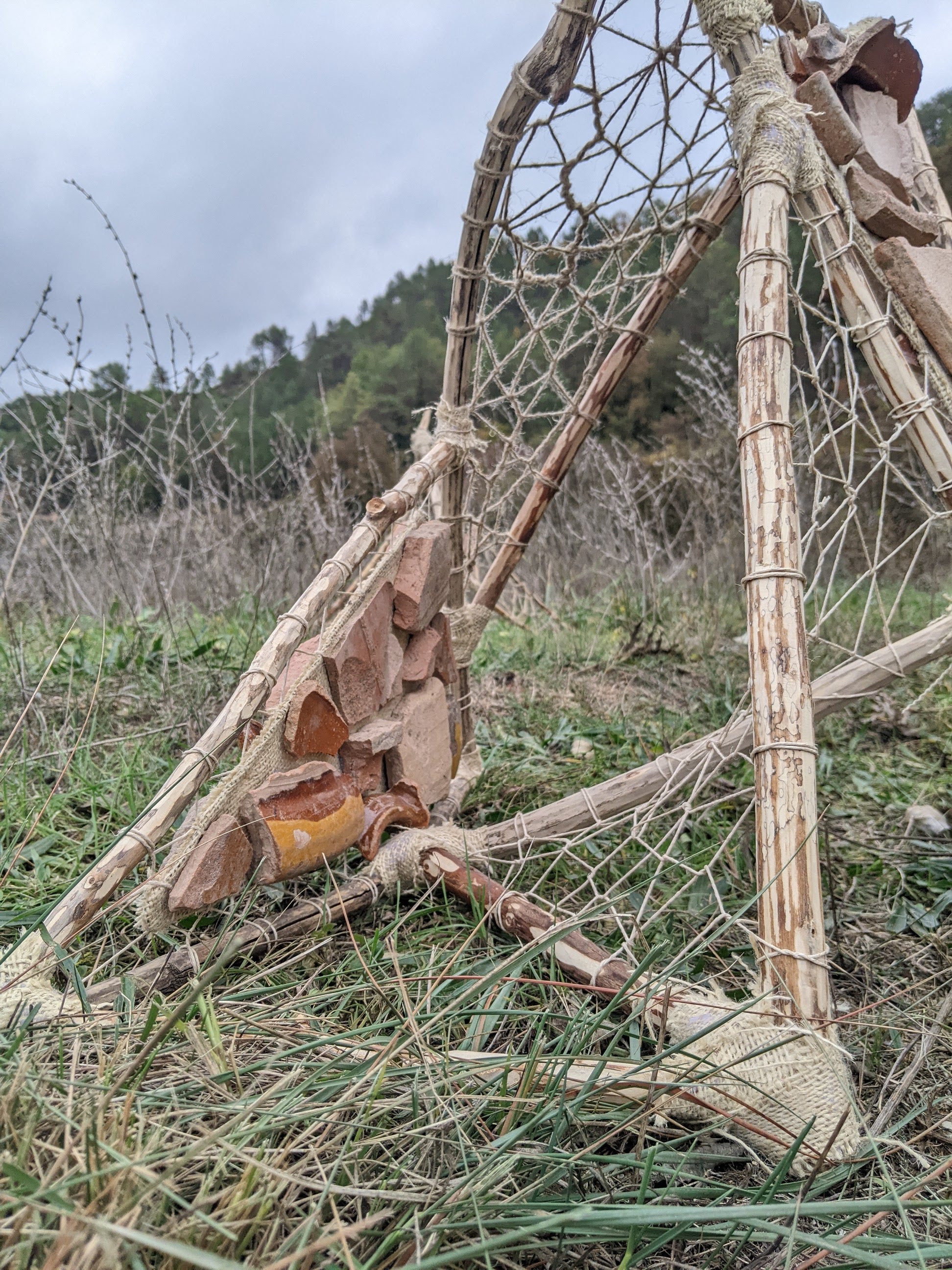Travis Apel
Travis Apel is an artist who lives and works in Omaha, Nebraska, USA. His works are sculptural installations that he refers to as ‘transgression on ecology’, made in opposition to the culture of single-use and waste. His interests lie in geology, permaculture, sociology and interpreting nature.
During a residency at Cel del Nord, Travis made work inspired by the community of Oristà (where Cel del Nord is located). As of November 2022, this work, entitled La Comunitat, is exhibited as part of a Land Art exhibition hosted in the village.
To read more visit his website travisapel.com
You didn't take any work back home with you. Had you planned it that way?
Before traveling to Oristà I thought about this. The virtue of reciprocity is important to me. Though I wasn't sure about how the physical project would develop, I felt certain I’d leave the work behind. The Cel del Nord residency has the potential to become a small museum featured with a growing collection of art objects that were made on site.
Travis Apel , studio space, Cel del Nord 2022
Collected items, Travis Apel in Oristà 2022
Collected items, Travis Apel in Oristà 2022
The work was made almost entirely from things you found in the surrounding area. What drew you to those things?
I find that gathering material resources around an unfamiliar place is a practical solution to developing work in a short timeframe. The experience of taking in the senses of the Catalan countryside was the initial set of inputs for beginning my project. I tuned in to the most common of human rituals in hunting and gathering. I started off with a hike. The angles and lines of cascading mosses clinging onto branches, the tree roots anchored in rocky terrain, and daily walks on pathways informed my interpretations of exploring the land. On one of my walks I discovered several shards of broken ceramic pottery and Spanish tiles incorporated in the roadside and north slope of Sant Sesbatià chapel. Even some of the pottery is tilled into the field adjacent to where I first spotted the littered pieces. Widespread evidence of these shards led me to understand that I was not trampling on an old archaeological site, but acknowledging their reconfigured return to Earth. So, I collected some to help contextualize my study back at the studio.
La Comunitat, 1 of 3
La Comunitat, 2 of 3
La Comunitat, 3 of 3
Something that stands out in the pieces is the tension created by cord you twisted, and between the batons that you made from gathered sticks. What can you say about that tension? Was it purely practical?
The tension of twisted cords as part of La Comunitat is an aesthetic way for me to use netting to symbolize networks within communities. They are a way for me to express interdependence. The whole structure relies on the reinforcement of cordage. Some of the threads weave over one another repeatedly. I thought about the pathways I frequented on daily walks. It reminds me to always think about keeping a check on the effects of my footprint.
La Comunitat, full series
We're grateful that the work lives here now, and we can treasure it. But I am also interested in the idea of ownership, and the very loaded word 'worth'.
Yes I agree, the words ownership and worth can be rhetorically loaded. So, do you own the work that I made? Or, does it still belong to the universe? Are you stewards of the set of sculptures? Do you possess them? I’m not sure what is accurate about this language, but I believe that ownership is a concept that many people regard as a self-evident truth.
My experience at Cel del Nord was very therapeutic, especially once I understood how I physically connected with the materials. The materials came from their immediate geography, Oristà. They belong to the community and have been reconfigured into a series of three, 3D sketches titled, La Comunitat. Even though because of the language barrier I rarely communicated with the people living in the village, I acknowledge that they live in a community of the human ecosystem. The organic materials and the ceramic bits made and discarded from local artisans have origins from the soil community. Hemp twine and burlap that I brought with me are plant-based materials grown from the ground. The hot glue is derived from petroleum extracted from the earth. This is perhaps a long way to address your question, but epistemologically speaking, I don’t know how anyone can own La Comunitat. Whether in private collections, or my studio, it’s difficult for me to understand if anyone really owns the artworks. In time they may require care like dusting, conserving, reapplications of finishes, etc… In the end we are curators, surveyors, and stewards of the work.
La Comunitat, situated between a hiking trail and an antique font in the periphery of Oristà.
You were talking while you were about the process of making the work being the work, before the object itself was the work. Does that something that strikes a chord?
Though many people don’t see it my way, I view art as a verb, not as a noun. It’s a process, instead of a result. When mentioning that I meant to refer to it as an act of acquiring materials, brainstorming, design layout, construction, painting and/or finishing. Those combinations of tasks become artwork. I am growing more conscious of documenting my work the best I can. Of course it doesn’t always turn out that way if I forget to take photographs of my process.
Close up view, La Comunitat
Travis Apel hiking in Monserrat, Barcelona, Spain










